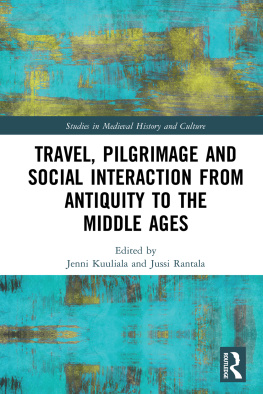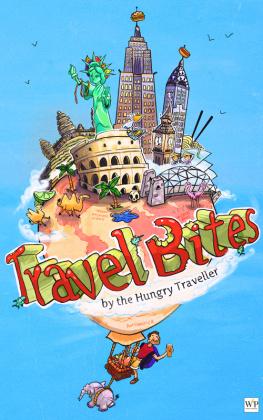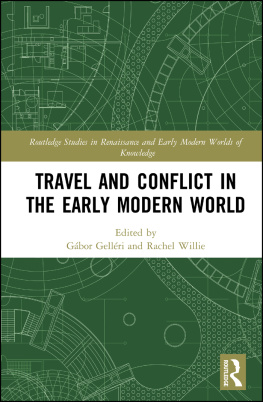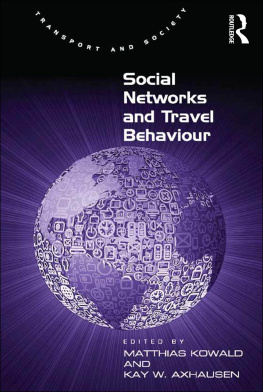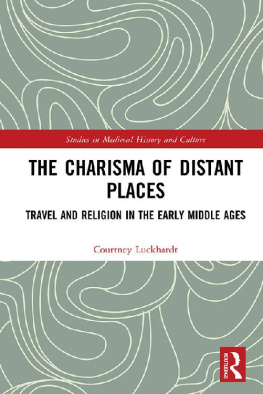Travel, Pilgrimage and Social Interaction from Antiquity to the Middle Ages
Mobility and travel have always been key characteristics of human societies, having various cultural, social and religious aims and purposes. Travels shaped religions and societies and were a way for people to understand themselves, this world and the transcendent. This book analyses travelling in its social context in ancient and medieval societies. Why did people travel, how did they travel and what kind of communal networks and negotiations were inherent in their travels? Travel was not only the privilege of the wealthy or the male, but people from all social groups, genders and physical abilities travelled. Their reasons to travel varied from profane to sacred, but often these two were intermingled in the reasons for travelling. The chapters cover a long chronology from Antiquity to the end of the Middle Ages, offering the reader insights into the developments and continuities of travel and pilgrimage as a phenomenon of vital importance.
Jenni Kuuliala is a university researcher at Tampere University, Finland. Her research interests include hagiography, pilgrimage and the social history of medicine in the Middle Ages and the early modern period.
Jussi Rantala is a postdoctoral researcher at Tampere University, Finland. His research concentrates on historiography, identity and power in Classical Antiquity, particularly in the Roman Empire.
Studies in Medieval History and Culture
Recent titles include
The Charisma of Distant Places
Travel and Religion in the Early Middle Ages
Courtney Luckhardt
The Death Penalty in Late Medieval Catalonia
Evidence and Signification
Flocel Sabat
Church, Society and University
The Paris Condemnation of 1241/4
Deborah Grice
The Sense of Smell in the Middle Ages
A Source of Certainty
Katelynn Robinson
Travel, Pilgrimage and Social Interaction from Antiquity to the Middle Ages
Edited by Jenni Kuuliala and Jussi Rantala
Travel, Pilgrimage and Social Interaction from Antiquity to the Middle Ages
Edited by Jenni Kuuliala and
Jussi Rantala

First published 2020
by Routledge
2 Park Square, Milton Park, Abingdon, Oxon OX14 4RN
and by Routledge
52 Vanderbilt Avenue, New York, NY 10017
Routledge is an imprint of the Taylor & Francis Group, an informa business
2020 selection and editorial matter, Jenni Kuuliala and Jussi Rantala; individual chapters, the contributors
The right of Jenni Kuuliala and Jussi Rantala to be identified as the authors of the editorial material, and of the authors for their individual chapters, has been asserted in accordance with sections 77 and 78 of the Copyright, Designs and Patents Act 1988.
All rights reserved. No part of this book may be reprinted or reproduced or utilised in any form or by any electronic, mechanical, or other means, now known or hereafter invented, including photocopying and recording, or in any information storage or retrieval system, without permission in writing from the publishers.
Trademark notice : Product or corporate names may be trademarks or registered trademarks, and are used only for identification and explanation without intent to infringe.
British Library Cataloguing-in-Publication Data
A catalogue record for this book is available from the British Library
Library of Congress Cataloging-in-Publication Data
A catalog record has been requested for this book
ISBN: 978-0-367-13756-4 (hbk)
ISBN: 978-0-429-02845-8 (ebk)
Typeset in Times New Roman
by Deanta Global Publishing Services, Chennai, India
Contents
JENNI KUULIALA AND JUSSI RANTALA
EMMA-JAYNE GRAHAM
RAY LAURENCE
KATARIINA MUSTAKALLIO
JAAKKOJUHANI PELTONEN
SANNA JOSKA
JUSSI RANTALA AND VILLE VUOLANTO
EVA-MARIA BUTZ AND ALFONS ZETTLER
KLAUS HERBERS
CHRISTIAN LAES
M. CECILIA GAPOSCHKIN
SARA ELLIS NILSSON
FABIENNE MEIERS
STEFAN SCHRDER
LAURI UUSITALO
Most of the papers included in this volume were first presented at the conference On the Road. Travels, Pilgrimages and Social Interaction: Passages from Antiquity to the Middle Ages VI at the University of Tampere in 2015. Thus, the editors wish to thank all the participants of the occasion for inspiring presentations and discussions. The conference was made possible by support from The Federation of Finnish Learned Societies and the School of Social Sciences and Humanities at the University of Tampere, to which we also express our gratitude. Finally, we would like to thank all the other members of the organizing committee: Sari Katajala-Peltomaa, Christian Krtzl, Katariina Mustakallio, Miikka Tamminen, Lauri Uusitalo and Ville Vuolanto, as well as all the other people who efficiently took care of practical issues during the conference.
Jenni Kuuliala and Jussi Rantala
Jenni Kuuliala and Jussi Rantala
Travel has always been inherent in all human societies, shaping and changing the lives of individuals and communities. The motives for travel could be economic, religious, political, personal, or all of these, yet they always had communal undertones. This volume focuses on social and cultural approaches to travelling, mobility, and pilgrimages from Classical Antiquity to early Christian centuries and the Late Middle Ages in Western Europe.
The chapters in this volume concentrate on cultural and social interaction before, during, and after periods of travel. What motivations were there for ancient and medieval people to get on the road, and what negotiations and networks were intrinsic to travelling? How were these later reported and what cultural meanings were given to travels? As this volume has a longue dure perspective, the same topics are addressed within chapters focusing on different time periods and cultures. Encounters with the sacred and the role of religion in travel are analysed from both non-Christian and Christian perspectives. Similarly, attention is given to the different means and experiences of travel in varying contexts. The chapters therefore discuss the diversity of people travelling and the diversity in their experiences of travel. Pilgrimage and, generally, religious journeys in various forms is the central theme in most of the chapters. However, sacred travels are not addressed only as a medieval, Christian concept; their non-Christian roots and development are analysed as well. In order to trace continuity as well as change throughout this long time span, the chapters proceed chronologically, from mid-Republican Rome all the way to the Late Middle Ages.
Travel shaped the cultural and social landscape not just as an activity occurring at a moment in time, but also as the theme of stories later retold. The act of travelling, as well as narrations about travel, also shaped religious and cultural practices. The earliest records of travel during Antiquity were travel poems, the most famous and culturally influential one being Homer's Odyssey , which came to serve as the embodiment of the restlessness of travel. A premodern traveller had to negotiate these factors in varying ways, some of which were intertwined with the religious practices of travel while other approaches were much more practical. All of these aspects shaped personal experiences and the later retelling of travel events.
While the descriptions of religious travel are not abundant in chronicles of the pre-Christian world compared to later Christian narratives, we do have many traces of sacred travels recorded in Antiquity. Considering the Greek world, even if we lack individual testimonies, epigraphy and literature give us enough glimpses into the past to realize that the Greeks travelled to their sacred places for over a thousand years, at least from the sixth century BCE to the fourth century CE, and that sacred travellers were a common sight on Greek roads and landscapes in general. The most famous destinations of these journeys were various Panhellenic games, such as Olympian, or the most important oracles, particularly the one at Delphi, yet the significance of religious travel went well beyond these.

